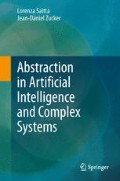Abstract
In this chapter an informal treatment of the basic ideas of what, in our view, abstraction should is reported. In particular, the notion of abstraction is linked to that of information hiding, and the nature of the abstraction as an intensional property of system descriptions is suggested. Moreover, grounding abstraction on a configuration space (containing all the possible descriptions of a system, given a set of sensors) allows a clear distinction to be made among the cognate notions of abstraction, approximation and reformulation. Finally, the relationships between abstraction and generalization are discussed in depth.
Access this chapter
Tax calculation will be finalised at checkout
Purchases are for personal use only
Notes
- 1.
As it will be discussed in the next chapter, the system \(\mathcal{S }\) needs not to be a physical one, and “measuring” is to be taken in a wide sense, as discussed also by Floridi [175].
- 2.
See Sect. 2.2.
- 3.
“The true way and order for drawing all parts and members of the human body”.
- 4.
See Sect. 2.1.
- 5.
See Sect. 2.3.
- 6.
See the pioneering work by Michalski [367].
- 7.
See Sect. 2.3.
- 8.
See Sect. 2.6.
- 9.
\({ COV }(\varphi )\) is the set of models of \(\varphi \) in \(\mathcal{A }\).
- 10.
For instance, aggregation is only meaningful for abstraction, whereas omitting details pertains to both abstraction and generalisation.
- 11.
See Sect. 2.6.
- 12.
See Sect. 2.6.
Author information
Authors and Affiliations
Corresponding author
Rights and permissions
Copyright information
© 2013 Springer Science+Business Media New York
About this chapter
Cite this chapter
Saitta, L., Zucker, JD. (2013). Boundaries of Abstraction. In: Abstraction in Artificial Intelligence and Complex Systems. Springer, New York, NY. https://doi.org/10.1007/978-1-4614-7052-6_5
Download citation
DOI: https://doi.org/10.1007/978-1-4614-7052-6_5
Published:
Publisher Name: Springer, New York, NY
Print ISBN: 978-1-4614-7051-9
Online ISBN: 978-1-4614-7052-6
eBook Packages: Computer ScienceComputer Science (R0)

